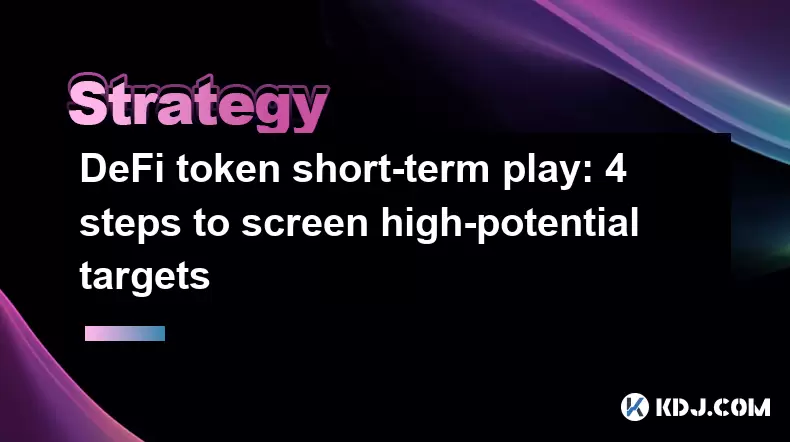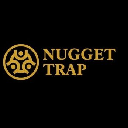-
 bitcoin
bitcoin $114684.631706 USD
-0.87% -
 ethereum
ethereum $4228.677447 USD
1.58% -
 bnb
bnb $1294.880693 USD
-1.16% -
 tether
tether $1.000819 USD
-0.02% -
 xrp
xrp $2.605138 USD
2.79% -
 solana
solana $209.908690 USD
5.89% -
 usd-coin
usd-coin $0.999903 USD
-0.03% -
 dogecoin
dogecoin $0.213423 USD
2.93% -
 tron
tron $0.322721 USD
-0.10% -
 cardano
cardano $0.727247 USD
3.66% -
 hyperliquid
hyperliquid $42.339456 USD
6.05% -
 chainlink
chainlink $19.910811 USD
5.16% -
 ethena-usde
ethena-usde $1.000557 USD
0.00% -
 stellar
stellar $0.349734 USD
2.69% -
 bitcoin-cash
bitcoin-cash $543.848687 USD
-0.21%
DeFi token short-term play: 4 steps to screen high-potential targets
To screen high-potential DeFi tokens for short-term gains, follow a four-step process: analyze market trends, evaluate token fundamentals, assess tokenomics and liquidity, and conduct technical analysis.
May 25, 2025 at 09:14 am

In the fast-paced world of decentralized finance (DeFi), identifying high-potential tokens for short-term gains can be a lucrative strategy for investors. This article outlines a four-step process to screen and select DeFi tokens that show promise for short-term plays. By following these steps, you can enhance your ability to spot opportunities in the volatile yet rewarding DeFi market.
Step 1: Analyze Market Trends and Sentiment
The first step in screening high-potential DeFi tokens for short-term plays involves analyzing market trends and sentiment. This step is crucial as it helps you understand the broader market environment in which these tokens operate.
Monitor DeFi market indicators: Keep an eye on key metrics such as total value locked (TVL) in DeFi protocols, transaction volumes, and liquidity pools. Rising TVL and increased transaction volumes often indicate growing interest and potential for short-term gains.
Track social media and forums: Platforms like Twitter, Reddit, and specialized DeFi forums are invaluable for gauging sentiment. Look for mentions of new projects, partnerships, or updates that could drive short-term price movements.
Use sentiment analysis tools: Tools like LunarCrush or Sentiment can help quantify the sentiment around specific tokens. Positive sentiment often correlates with short-term price increases.
By staying informed about market trends and sentiment, you can better position yourself to identify tokens with short-term potential.
Step 2: Evaluate Token Fundamentals
Once you have a sense of the market environment, the next step is to evaluate the fundamentals of individual tokens. This involves looking at the underlying project's technology, team, and use case.
Assess the project's technology: Investigate the blockchain or smart contract technology behind the token. Is it innovative? Does it solve a real problem in the DeFi space? Projects with strong technological foundations are more likely to attract attention and investment.
Research the team: A competent and experienced team is a critical factor in a project's success. Look for information on the team's background, previous projects, and their involvement in the DeFi community.
Understand the token's use case: What purpose does the token serve within its ecosystem? Tokens with clear and valuable use cases are more likely to experience short-term price appreciation.
By thoroughly evaluating a token's fundamentals, you can identify projects that are not only promising but also likely to see short-term gains.
Step 3: Analyze Tokenomics and Liquidity
The third step in your screening process is to analyze the tokenomics and liquidity of the DeFi tokens you are considering. Tokenomics refers to the economic model of the token, including its supply, distribution, and incentives.
Review the token's supply and distribution: Understand the total supply, circulating supply, and how the tokens are distributed. Tokens with a limited supply and a well-distributed allocation are often more attractive for short-term plays.
Evaluate the token's liquidity: High liquidity is essential for short-term trading. Check the trading volume and the depth of the order book on major exchanges. Tokens with high liquidity are easier to buy and sell, reducing the risk of slippage.
Consider the token's incentives: Look for tokens that offer staking rewards, yield farming opportunities, or other incentives that could drive demand and increase the token's value in the short term.
By carefully analyzing tokenomics and liquidity, you can better assess the potential for short-term gains.
Step 4: Conduct Technical Analysis
The final step in screening high-potential DeFi tokens for short-term plays is to conduct technical analysis. This involves studying price charts and technical indicators to identify patterns and trends that can inform your trading decisions.
Use price charts: Analyze candlestick charts to identify support and resistance levels, trend lines, and chart patterns. These can provide insights into potential price movements.
Apply technical indicators: Indicators like moving averages, the Relative Strength Index (RSI), and the Moving Average Convergence Divergence (MACD) can help you gauge momentum and potential reversals.
Look for entry and exit points: Based on your analysis, identify optimal entry and exit points for your trades. Short-term plays often require quick decisions, so having clear entry and exit strategies is crucial.
By incorporating technical analysis into your screening process, you can enhance your ability to time your trades effectively.
Implementing Your Screening Strategy
Now that you have a comprehensive four-step process for screening high-potential DeFi tokens, it's time to put it into practice. Here's how you can implement your strategy:
Create a watchlist: Based on your analysis, compile a list of tokens that meet your criteria for short-term potential. Regularly review and update this watchlist to stay on top of new opportunities.
Set up alerts: Use trading platforms or third-party tools to set up price alerts and news notifications for the tokens on your watchlist. This will help you stay informed and react quickly to market changes.
Monitor and adjust: Continuously monitor the performance of the tokens on your watchlist and adjust your strategy as needed. The DeFi market is highly dynamic, so flexibility is key.
By diligently following these steps and implementing your strategy, you can increase your chances of identifying and capitalizing on high-potential DeFi tokens for short-term plays.
Frequently Asked Questions
Q: How often should I update my watchlist of DeFi tokens?A: It's advisable to review and update your watchlist at least weekly, or more frequently if there are significant market changes or new project developments. The DeFi space moves quickly, so staying updated is crucial for identifying new opportunities.
Q: Can I use this strategy for long-term investments as well?A: While this strategy is designed for short-term plays, some of the steps, such as evaluating token fundamentals and tokenomics, can also be useful for long-term investments. However, long-term strategies typically require additional considerations, such as the project's long-term viability and market position.
Q: What are the risks associated with short-term trading of DeFi tokens?A: Short-term trading of DeFi tokens carries significant risks, including high volatility, liquidity risks, and the potential for rapid price fluctuations. It's important to manage your risk by setting stop-loss orders and only investing what you can afford to lose.
Q: Are there any tools or platforms that can help with the screening process?A: Yes, several tools and platforms can assist with the screening process. For market trends and sentiment, platforms like CoinGecko and CoinMarketCap provide valuable data. For technical analysis, tools like TradingView offer comprehensive charting and analysis features. Additionally, specialized DeFi analytics platforms like DeFi Pulse can help with evaluating token fundamentals and liquidity.
Disclaimer:info@kdj.com
The information provided is not trading advice. kdj.com does not assume any responsibility for any investments made based on the information provided in this article. Cryptocurrencies are highly volatile and it is highly recommended that you invest with caution after thorough research!
If you believe that the content used on this website infringes your copyright, please contact us immediately (info@kdj.com) and we will delete it promptly.
- XRP Price Prediction: Weekend Rollercoaster or Rally?
- 2025-10-12 08:45:16
- Bittensor (TAO): Super Bullish Signals Point to Potential 2x Rally
- 2025-10-11 10:25:12
- Silver Price Correction: Navigating the Dip & Identifying Key SEO Keywords
- 2025-10-11 10:25:12
- Decoding Crypto Trends: Bittensor's Bull Run, Cardano's Dip, and LivLive's Presale Buzz in 'Uptober 2025'
- 2025-10-12 08:45:16
- MoonBull: The Crypto Meme Coin Promising 1000x Gains?
- 2025-10-11 10:30:01
- Crypto Payroll Revolution: Stablecoins, Altcoins, and the Future of Salary Payments
- 2025-10-11 10:30:01
Related knowledge

Practical parameter settings for a Bitcoin multi-timeframe moving average system
Sep 18,2025 at 10:54pm
Optimizing Timeframe Combinations for Bitcoin Trading1. Selecting appropriate timeframes is crucial when building a multi-timeframe moving average sys...

How can I filter out false breakouts in Dogecoin high-frequency trading?
Sep 22,2025 at 01:00am
Understanding False Breakouts in Dogecoin Trading1. A false breakout occurs when Dogecoin's price appears to move beyond a defined support or resistan...

Techniques for identifying tops and bottoms in the Bitcoin on-chain NVT model
Sep 20,2025 at 07:54pm
Understanding the NVT Model in Bitcoin Analysis1. The Network Value to Transactions (NVT) ratio is often described as the 'P/E ratio' of the cryptocur...

What does the surge in open interest in Bitcoincoin futures mean?
Sep 20,2025 at 11:18pm
Understanding the Surge in Dogecoin Futures Open Interest1. A surge in open interest within Dogecoin futures indicates a growing number of active cont...

How can I use the Ethereum USDT premium to gauge market sentiment?
Sep 18,2025 at 11:55pm
Understanding the Ethereum USDT Premium1. The Ethereum USDT premium refers to the price difference between USDT (Tether) traded on Ethereum-based plat...

What should I do if Ethereum staking yields decline?
Sep 20,2025 at 06:18am
Understanding the Causes Behind Declining Ethereum Staking Yields1. The Ethereum network transitioned to a proof-of-stake consensus mechanism with the...

Practical parameter settings for a Bitcoin multi-timeframe moving average system
Sep 18,2025 at 10:54pm
Optimizing Timeframe Combinations for Bitcoin Trading1. Selecting appropriate timeframes is crucial when building a multi-timeframe moving average sys...

How can I filter out false breakouts in Dogecoin high-frequency trading?
Sep 22,2025 at 01:00am
Understanding False Breakouts in Dogecoin Trading1. A false breakout occurs when Dogecoin's price appears to move beyond a defined support or resistan...

Techniques for identifying tops and bottoms in the Bitcoin on-chain NVT model
Sep 20,2025 at 07:54pm
Understanding the NVT Model in Bitcoin Analysis1. The Network Value to Transactions (NVT) ratio is often described as the 'P/E ratio' of the cryptocur...

What does the surge in open interest in Bitcoincoin futures mean?
Sep 20,2025 at 11:18pm
Understanding the Surge in Dogecoin Futures Open Interest1. A surge in open interest within Dogecoin futures indicates a growing number of active cont...

How can I use the Ethereum USDT premium to gauge market sentiment?
Sep 18,2025 at 11:55pm
Understanding the Ethereum USDT Premium1. The Ethereum USDT premium refers to the price difference between USDT (Tether) traded on Ethereum-based plat...

What should I do if Ethereum staking yields decline?
Sep 20,2025 at 06:18am
Understanding the Causes Behind Declining Ethereum Staking Yields1. The Ethereum network transitioned to a proof-of-stake consensus mechanism with the...
See all articles










































































